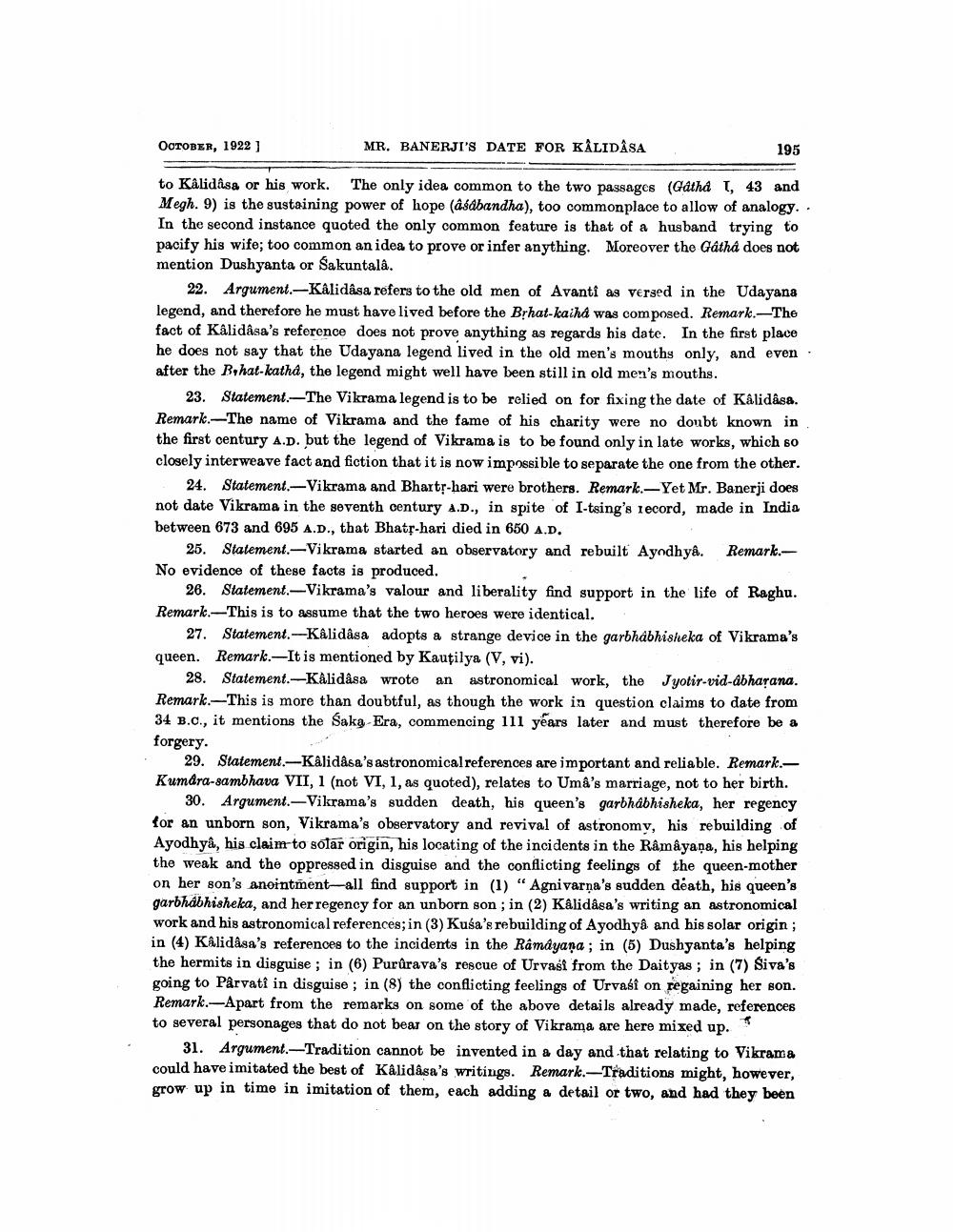________________
OCTOBER, 1922
MR. BANERJI'S DATE FOR KÅLIDÅSA
195
to Kalidasa or his work. The only idea common to the two passages (Gatha T, 43 and Megh. 9) is the sustaining power of hope (âsábandha), too commonplace to allow of analogy.. In the second instance quoted the only common feature is that of a husband trying to pacify his wife; too common an idea to prove or infer anything. Moreover the Gatha does not mention Dushyanta or Sakuntala.
22. Argument.-Kalidasa refers to the old men of Avanti as versed in the Udayana legend, and therefore he must have lived before the Brhat-kaiha was composed. Remark.--The fact of Kalidasa's reference does not prove anything as regards his date. In the first place he does not say that the Udayana legend lived in the old men's mouths only, and even after the B.hat-katha, the legend might well have been still in old men's mouths.
23. Statement.-The Vikrama legend is to be relied on for fixing the date of Kalidasa. Remark. --The name of Vikrama and the fame of his charity were no doubt known in the first century A.D. but the legend of Vikrama is to be found only in late works, which so closely interweave fact and fiction that it is now impossible to separate the one from the other.
24. Statement.- Vikrama and Bharts-hari were brothers. Remark.-Yet Mr. Banerji does not date Vikrama in the seventh century A.D., in spite of I-tsing's record, made in India between 673 and 695 A.D., that Bhatr-hari died in 650 A.D.
25. Statement.--Vikrama started an observatory and rebuilt Ayodhyâ. Remark. No evidence of these facts is produced.
26. Statement.-Vikrama's valour and liberality find support in the life of Raghu. Remark.-This is to assume that the two heroes were identical.
27. Statement.-Kalidasa adopts a strange device in the garbhabhisheka of Vikrama's queen. Remark.-It is mentioned by Kautilya (V, vi).
28. Statement.--Kalidasa wrote an astronomical work, the Jyotir-vid-abharana. Remark. --This is more than doubtful, as though the work in question claims to date from 34 B.C., it mentions the Saka - Era, commencing 111 years later and must therefore be a forgery.
29. Statement.-Kalidasa's astronomical references are important and reliable. Remark.Kumdra-sambhava VII, 1 (not VI, 1, as quoted), relates to Umâ's marriage, not to her birth.
30. Argument.-Vikrama's sudden death, his queen's garbhabhisheka, her regency for an unborn son, Vikrama's observatory and revival of astronomy, his rebuilding of Ayodhyâ, his claim to solar origin, his locating of the incidents in the Ramayana, his helping the weak and the oppressed in disguise and the conflicting feelings of the queen-mother on her son's anointment--all find support in (1) “Agnivarna's sudden death, his queen's garbhabhisheka, and her regency for an unborn son; in (2) Kalidasa's writing an astronomical work and his astronomical references; in (3) Kuśa's rebuilding of Ayodhyâ and his solar origin; in (4) Kalidasa's references to the incidents in the Ramayana ; in (5) Dushyanta's helping the hermits in disguise ; in (6) Purúrava's rescue of Urvasi from the Daityas ; in (7) Siva's going to Pârvati in disguise ; in (8) the conflicting feelings of Urvasi on regaining her son. Remark.-Apart from the remarks on some of the above details already made, references to several personages that do not bear on the story of Vikrama are here mixed up.
31. Argument.-Tradition cannot be invented in a day and that relating to Vikrama could have imitated the best of Kalidasa's writings. Remark.-Traditions might, however, grow up in time in imitation of them, each adding a detail or two, and had they been




